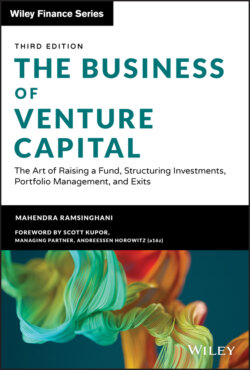Читать книгу The Business of Venture Capital - Mahendra Ramsinghani - Страница 33
Junior Partner, Hungry Partner
ОглавлениеPaul Graham of Y Combinator writes, “Junior persons scour the web looking for startups their bosses could invest in. The junior people will tend to seem very positive about your company. They're not pretending; they want to believe you're a hot prospect, because it would be a huge coup for them if their firm invested in a company they discovered. Don't be misled by this optimism. It's the partners who decide, and they view things with a colder eye.”14
Peter Thiel, investor and entrepreneur, points out that the junior person is often an advantageous starting point for entrepreneurs. “Tactically, the first thing to do is find someone who does need to make investments. That can mean finding a senior associate or a principal for your first pitch, not a senior partner. This contravenes the conventional wisdom that holds that you should not pitch to junior people. (“Don't pitch someone who can't write a check themselves.”) That wisdom is wrong. Junior people will give entrepreneurs a fair shake because they need good deals to their name. If they don't find those deals, they won't become senior, and they very much want to become senior. So seek these people out: they are motivated in a way more seasoned VCs are not… . No senior VC needs to do an investment. You should never forget that. Any senior VC that you're talking to is already wealthy and has many famous deals to show for it. Your company is probably not going to make a material difference to him but does present a significant chance of adding to his workload and failure rate; there will therefore be a certain amount of inertia against the deal … on average most deals don't pan out but do take time.15
While working full-time at a venture capital firm, each Kauffman Fellow engages in a two-year, hands-on apprenticeship that includes professional coaching in seven modules, mentoring by seasoned venture partners, and triennial sessions of industry and leadership curriculum. The program claims that the fellowship's value can be measured along three axes of investing: apprenticeship, leadership development, and being a part of a global network.
Each year, about 20 to 30 fellows are picked from a pool of about 200 applicants. The application process is a two-step dance, which is rigorous by any measure. The written application and the interview — reviewers include leading venture capitalists — look for a prior track record of accomplishments that are significant. Entrepreneurial background trumps operational background; in fact, it trumps everything else.
At the interview stage, the universe of 200 applicants narrows down by about a third. Each candidate is grilled by panels of four to five venture capitalists. The next stage is the finalist stage, where candidates who cross the finish line are then matched with firms who are seeking to bring on fresh talent. If any firm does not pick up a finalist, the process ends. For those selected, the sponsor venture capital firm pays a hefty tuition in addition to the salary for the two-year internship. These would-be Fellows are assigned mentors from established venture firms who, over the course of a two-year period, will provide insights and formal training into the art and science of venture investing.
Some of the common characteristics of Fellows include “a bias toward entrepreneurs; deep scientific, technology, or business domain expertise; an aspiration to contribute to the building of companies, either as an investor or as a startup leader; an appetite for risk, ambiguity, and unstructured environments; and humility, empathy, a sense of service, and unquestioned integrity.”17
